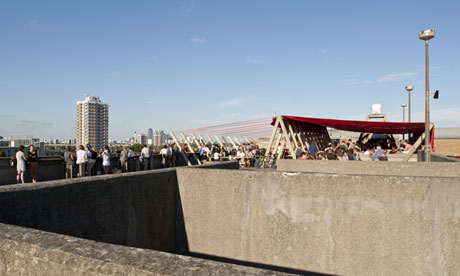
In a multi-story car park in Peckham, pianist Mark Knoop performs piece after piece without a break - Liszt, Schoenberg, Mozart, Feldman - like a fish slapping around on a marble block, gasping, desperate for comfort. Finally he begins knocking dejectedly on the piano's body. A group of people emerge from the shadows, and they slowly begin tearing the piano apart, removing its screws, ripping up the hammers so they flail impotently in the air. It feels like you're watching a serious assault. The audience film it on their phones. When the performers are done and applauded, people go over to the eviscerated body and peck at it like vultures.
This is Piano Activities, a 1962 piece by Fluxus artist Philip Corner, recreated for the climax of the excellent London contemporary music festival. As a performance, it's brilliantly disturbing and vivid; but as an act coming after two weeks of boundary-pushing creativity, it's ugly. Smashing and violating this instrument that gave so much over its life, at an (admittedly free) event high above one of the most deprived areas in London, is indulgence bordering on immorality. Before the festival, I suggested on Twitter that LCMF ditch the performance and give the piano to a local school instead; "that's a bit Daily Mail" was their response.
While censoring them would indeed have been wrong, destructive performance misreads the temperature of a culture where a siege mentality reigns. Various forces are at the gates - welfare cuts, permanent environmental change, information overload, banality - and each day is an attempt to row them back. When much of the world feels like it's being destroyed by forces beyond our control, an understandable response is to destroy something oneself, to act as a metaphor to highlight what's happening, or to wrest back a bit of agency even just for a few moments. Or to suggest and even enact the tearing down of an old culture so a new one can be built in its place.
That desire is what seemed to drive destructive performances of the 20th century. Einstürzende Neubauten's performance at the ICA in 1984 featured them wielding chainsaws and drilling down into the stage, a "Utopian idea of leaving the stage from underneath" according to Alexander Hacke of the band - breaking free of the parameters of institutional performance. Nam June Paik, another Fluxus artist, performed One for Violin in 1962, a piece where he slowly brought a violin above his head before smashing it against a table, the lights suddenly extinguishing. Coming amid John Cage's scorched-earth policy towards music, Paik's nihilism is similarly bracing and revelatory. That nihilism can also be seen in the Yardbirds guitar-smashing performance in Antonioni's film Blow-Up, where the destruction catalyses the previously inert audience into chaos, suggesting a latent violence behind the newfound freedoms of the swinging 60s.
But post-Cage, post-punk, destruction feels creatively redundant; if the avant-garde is about chipping away at the coalface of culture, then presenting a Fluxus performance excavated decades previously is utterly conservative. Once music has been razed to the ground by Cage, Paik and others, it's time to build. More importantly, in a networked culture where we're already painfully aware of the damage wrought by governments and industry we should know better than to merely destroy.
Ultimately, destruction is a privilege and comes from a position of luxury. The artist Michael Landy destroyed all of his worldly possessions in his 2001 piece Break Down, but did so within the gilt-edged walls of the international art scene - indeed, its high profile and daring actually raised his value, further insulating him from harm. Rock stars smash their guitars knowing that there's a ready stream of replacements; LCMF sanctioned the piano's destruction with their funding banked. There's very little jeopardy in their actions. What would have been more daring is to divert funds from their corporate sponsors (including Dow Jones and Agnès B) back into the community via the infrastructure of a grand piano.
According to critical theorist Walter Benjamin in his essay The Destructive Character, destruction isn't necessarily about the destructive act but the possibilities it opens up: "What exists he reduces to rubble - not for the sake of the rubble, but for that of the way leading through it." As a tactic for creativity, it's valuable. But when paths are closed off in very real ways, via cuts and deprivation, others must be kept open.
No comments:
Post a Comment